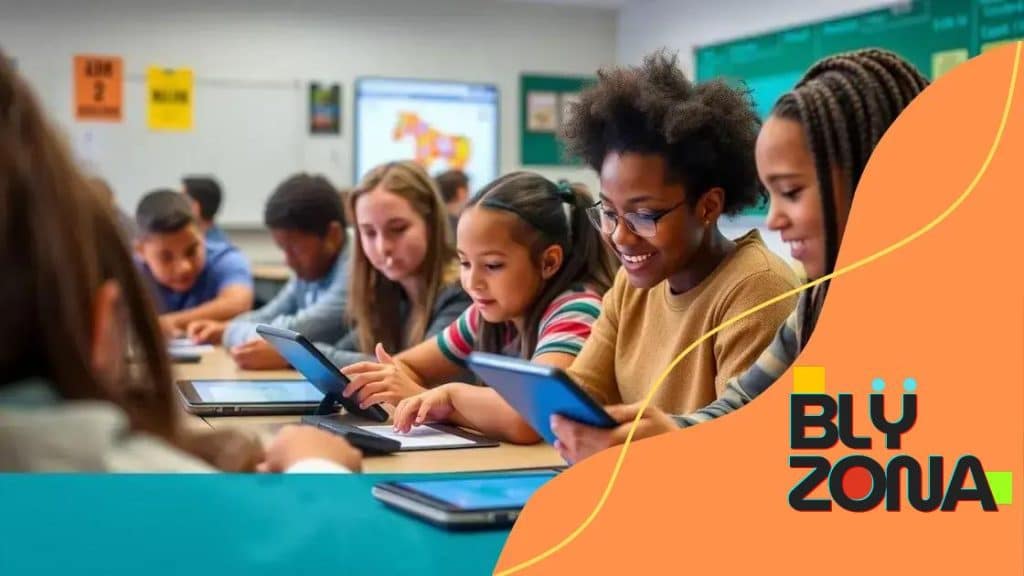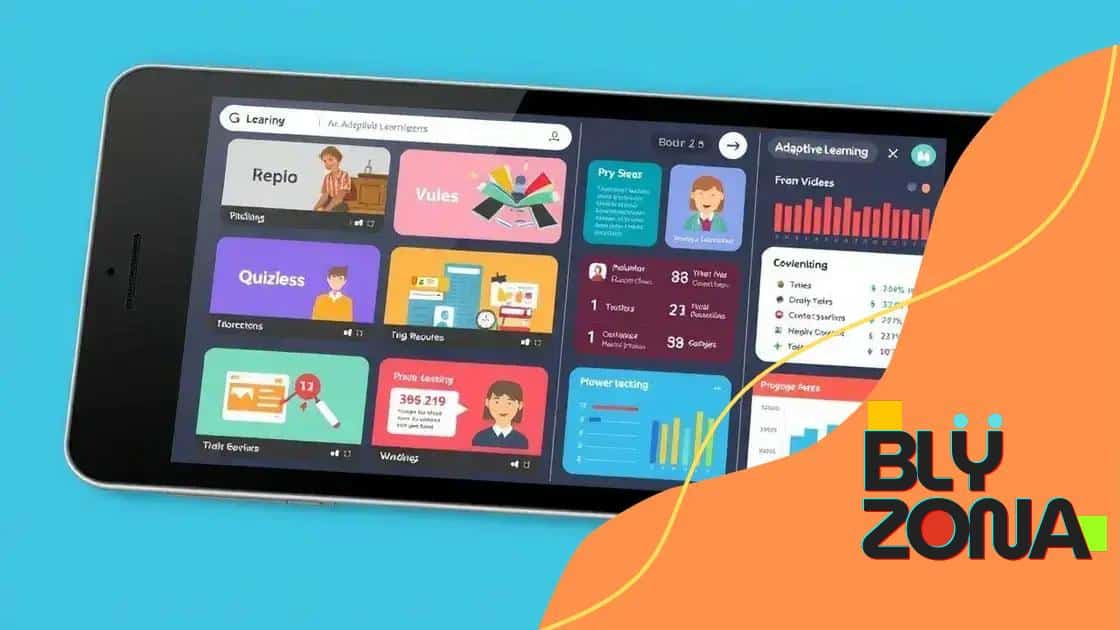Adaptive learning tech for special education: a game changer

Adaptive learning technology in special education personalizes learning experiences, enhances student engagement, and improves academic outcomes by tailoring content to individual needs and providing real-time feedback.
Adaptive learning tech for special education is changing how educators approach diverse learning needs. Have you ever wondered how technology could tailor education to fit every child? Let’s dive into this innovative field and explore its impact.
Understanding adaptive learning technology
Understanding adaptive learning technology is essential for anyone involved in education, especially in special education. This innovative approach tailors learning experiences to meet the individual needs of students. By adjusting the content, pace, and learning style, this technology ensures that every learner can thrive.
How Adaptive Learning Works
Adaptive learning systems collect data on how students interact with the material. This data informs the system to make real-time adjustments. For example, if a student struggles with a specific concept, the technology can present alternative explanations or exercises that fit the learner’s needs.
Benefits of Adaptive Learning Technology
- Personalized learning experiences for every student.
- Immediate feedback that helps students understand their mistakes.
- Engagement through interactive content that keeps learners interested.
- Flexibility in pacing, allowing students to progress at their own speed.
As students engage with the material, they receive content that becomes increasingly challenging or easier, based on their performance. This helps students build confidence and stay motivated. Imagine how different lessons feel when each piece is crafted just for you!
Furthermore, adaptive learning technology helps teachers identify gaps in knowledge. They can see trends in student performance and adjust their teaching methods to better support their class. This shared understanding between technology and educators fosters a more cohesive learning environment.
Benefits of adaptive learning in special education
The benefits of adaptive learning in special education are significant. This technology allows educators to create personalized learning environments that cater to individual student needs. Every student has unique strengths and challenges, and adaptive learning helps address these effectively.
Enhanced Engagement
When students interact with tailored content, they become more engaged in their learning. This engagement boosts their motivation and encourages them to participate actively in lessons. As they face less frustration with obstacles, their willingness to learn increases.
Personalized Learning Pathways
By using adaptive learning, teachers can develop customized learning pathways for each student. These pathways consider different learning styles and paces. For example, some students may benefit from visual aids, while others may excel with verbal instructions. This flexibility fosters an inclusive classroom environment.
- Respect for individual learning paces.
- Support for various learning styles.
- Immediate feedback to enhance understanding.
- Reduction of anxiety associated with traditional testing methods.
Moreover, with the detailed analytics provided by adaptive learning systems, educators can track progress more effectively. This data helps in identifying areas where students excel or struggle, allowing for targeted interventions. Schools can allocate resources better when they understand their students’ needs.
The use of adaptive learning tools also prepares students for a technologically advanced world. As they become accustomed to personalized digital education, they gain skills that will be vital in their future studies and careers. The technology not only helps improve learning outcomes but also boosts confidence in students with special needs.
Key features of effective adaptive learning tools

Key features of effective adaptive learning tools significantly enhance the learning experience for students. These tools use advanced technology to tailor educational content to fit individual learning needs, making education more accessible and engaging.
Personalization
One of the primary features of adaptive learning tools is their ability to personalize learning experiences. They assess students’ strengths and weaknesses and adjust the content accordingly. This means that no two students will have the same learning path, which helps each student progress at their own pace.
Real-Time Feedback
Effective adaptive learning platforms provide real-time feedback to students. This immediate response enables learners to understand their mistakes and correct them on the spot, fostering a deeper understanding of the material. Students receive guidance that is right when they need it, increasing their chances of success.
- Adaptive assessments to gauge knowledge.
- Learning analytics to track progress.
- Interactive content that keeps students engaged.
- Variety of resources for different learning styles.
Another vital aspect of these tools is the incorporation of data analytics. Educators can utilize this data to monitor student performance and adjust instruction as needed. With insights into how each student engages with the material, teachers can provide targeted support where it is most needed.
Additionally, effective adaptive learning tools should offer multi-modal learning resources. This means providing a mix of videos, quizzes, and interactive exercises that cater to different learning styles. Such diversity helps keep students motivated and engaged throughout their learning journey.
Implementing adaptive learning: best practices
Implementing adaptive learning effectively requires careful planning and execution. Schools and educators need to adopt best practices to ensure that this innovative approach benefits all students. Understanding these practices is key to a successful transition.
Assessing Needs
The first step in implementing adaptive learning is assessing the specific needs of students. Each learner is unique, with different strengths, weaknesses, and preferences. Schools should evaluate the current curriculum and identify areas where adaptive learning can fill gaps or enhance instruction. Surveys and assessments can help gather valuable data.
Choosing the Right Tools
Selecting the right adaptive learning tools is crucial. Educators should look for platforms that match their teaching style and meet their students’ needs. Consider features like real-time feedback, data analytics, and personalized content. A tool with a user-friendly interface will make it easier for both teachers and students to engage.
- Research different adaptive learning platforms.
- Read reviews and case studies from other educators.
- Test tools before full implementation.
- Ensure compatibility with existing technology.
Training staff to use adaptive learning technologies is another important aspect. Educators must feel comfortable using these tools to effectively incorporate them into their classrooms. Providing professional development sessions and ongoing support can help teachers gain confidence and proficiency.
Moreover, involving students and parents in the implementation process can create a more supportive environment. When students understand how adaptive learning works, they are more likely to engage with the technology. Involving parents keeps them informed and allows them to support their children’s learning at home.
Success stories in special education through adaptive learning
Success stories in special education through adaptive learning demonstrate how technology can transform lives. Many schools and educators have seen remarkable improvements in student engagement and achievement as they implement adaptive learning strategies. These real-world examples showcase the power of tailored educational experiences.
Case Study: Sarah’s Journey
One inspiring example is the story of Sarah, a student with dyslexia. Before her school adopted adaptive learning tools, Sarah struggled with reading and often felt frustrated. However, with the introduction of personalized learning software, her reading skills improved significantly. The tool adjusted the reading materials to match her comprehension level, providing engaging content that kept her interested.
School-Wide Implementation
A school in California demonstrated that when adaptive learning is implemented at a broader level, the results can be even more impressive. By integrating adaptive learning technologies across all subjects, they tailored lessons to meet individual needs. This initiative led to increased test scores and higher levels of student participation.
- Over 80% of students reported feeling more confident in their abilities.
- Teacher feedback indicated improved classroom dynamics.
- Parents noted significant changes in their children’s attitudes towards learning.
- Graduation rates increased by 15% in just one academic year.
One remarkable aspect of these success stories is how they highlight the potential for inclusive education. Students who once felt marginalized are now thriving. Adaptive learning not only benefits those with learning disabilities but also enriches the experiences of all students by allowing them to learn at their own pace.
Moreover, these stories inspire other schools to adopt similar technologies. As educators share their successes, they encourage a community of collaboration. The movement towards adaptive learning in special education continues to grow, with countless students benefiting from this innovative approach.
FAQ – Frequently Asked Questions about Adaptive Learning in Special Education
What is adaptive learning technology?
Adaptive learning technology personalizes the educational experience to meet individual student needs, adjusting content and pacing in real time.
How does adaptive learning benefit students in special education?
It provides customized learning pathways, immediate feedback, and encourages engagement, helping students succeed at their own pace.
Are there success stories from using adaptive learning in schools?
Yes, many schools have reported improved student performance, increased confidence, and enhanced classroom participation through adaptive learning.
What should schools consider when implementing adaptive learning tools?
Schools should assess student needs, choose the right technology, provide training for educators, and involve students and parents in the process.





